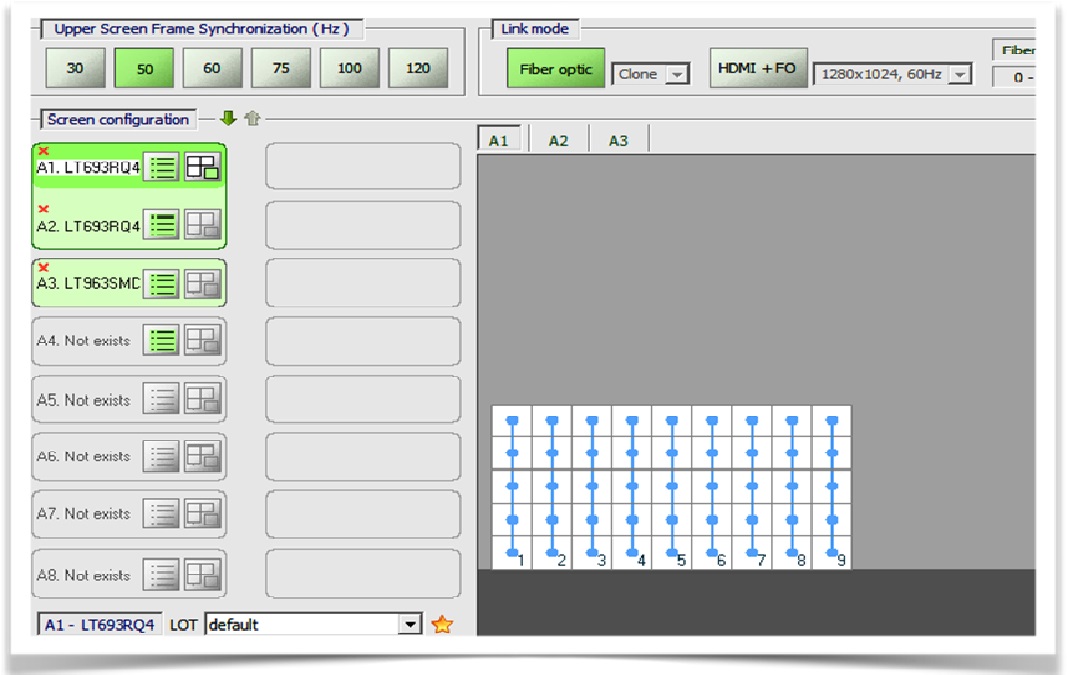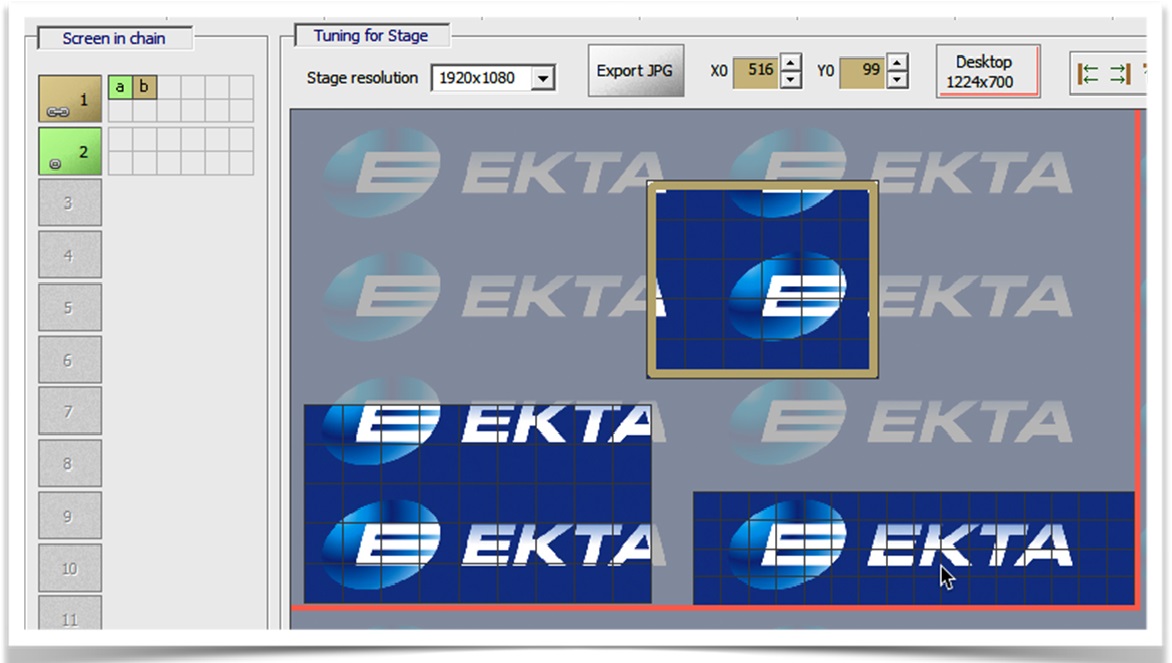
The control systems for LED video walls has been one of EKTA`s top directions of development for the last five years. The video processors series ERMAC was first presented to a wide range of professionals at the international exhibition Integrated Systems Europe 2011. But from year to year, the number of screens involved in projects was rapidly increasing and required new management solutions. So in response to market trends, EKTA has created new generations of video processors with a wide range of possibilities.
Everything we can do in our control systems, we can do in real-time. And we have one of the biggest advantages on the market right now it calls calibration technology for LED walls. What is it all about?
The advantages are:
- - The real-time calibration of each cluster after replacement of any module
- - The real-time color matching of different module series. Let’s say you have different LED lots or even from different LED factories
- - The real-time of color temperature
- - The real-time settings of brightness
- - The real-time adjustments of colors and 16/18-bit switching
We have intelligent cluster technology which means that different sensors in the cluster are enabling to achieve certain kinds of data like temperature, brightness and run time of each LED. All parameters are processed and stored inside the cluster, which means you can cope with the control system and achieve this data. The data is read directly from the cluster through a 6.1-gigabit fiber network system that means we don’t use any couple wire - everything is from the processor unit to the screen.
The automatic color adjustment of the screens is one of our biggest achievements. We can even have calibration with different delivery lots or LEDs from different manufacturers; this ensures up to 99% of complete illumination uniformity. Operation at a low brightness without any color loss. Everything is adjusted in real-time.
On the video, you see how easily you can change the tire on the video wall and achieve automatic color calibration of the surface in a few seconds. You can do the same with an LED module. This is really important especially for outdoor installations or digital signage installations when you have runtimes for 1, 2 or 3 years, 24/7. When cluster fails just take out the cluster (front service) and after the replacement the system will scan and achieve real-time information and make a complete uniformity wall. That means you have a technical freedom and don’t have trouble with a customer.
We also can do it through different LSCs – LEDs screen controllers. We can manage up to 32 screens with one of our control systems. So that means when we already have one adjusted screen in the chain we can power up another, retrieve the data from the first screen and in real-time all the clusters will be scanned. As a result, we receive a perfectly calibrated surface.
One of the special features of our systems is the automatic color adjustment even if we have different LED lots. We have a special tool. First, when we start the software, we retrieve all the information about all the clusters and the compound of the complete installation.
On the left side of the video, you can see the picture on the wall; it`s 3,000 K and on the right side it`s a complete different LED lot. We are powering up the wall. The color uniformity tool runs through and then gathers information and starts the color calibration. As a result, the complete LED wall has the same picture, has the same color uniformity and shows the same color temperature.
Everything is working with any color temperature; it doesn’t matter what kind of color temperature we are switching. We can manage the color temperature and the uniformity of the wall from 0,1 to 100% of brightness. This is one of the best advantages because 90% of all LED wall manufacturers are losing the uniformity if they are choosing the different color temperature.
You can see we starting from 0.1%, 10,000 K and then switch to the 3,000 K and lowering the brightness. You can see all the colors. This is really important for example for outdoor installations because you don`t have light pollutions. You have to lower the brightness of the LED wall in certain situations. Our LED walls in that kind of installations are running about 3 to 5% of brightness during the nighttime. And you have to make sure that the wall presents all the colors. Most failures begin at 10%, and this is not good to your customer.
The real-time adjustment of the color is made by software. We have an opportunity to make it spontaneous by mouse input or even by touch screen, or we can make it numeric with numbers. Everything is working in real-time, for example, grab the mouse, and inside of the triangle of color adjustment, everything works directly on the wall. We have a complete response from the wall directly in real-time.
The control system we have is an LED screen processor it`s a new ERMAC Ultra 10. We have multilevel image processor and scaler inside. We have the color Uniformity system; we can work with 4K pixel resolution that means one controller can handle up to 8.5 million of pixels. We can run 32 displays at a time from one controller. This is pretty neat because when we have an installation like shopping malls or something like this we just need one controller to run the entire shopping mall through LVL. The real-time adjustments through ERMAC are the color temperature from 3,000 K to 10,000 K, brightness from 0.1% to 100% with 1,024 gradations of each color, gamma curve correction. We have an output mixer built in, picture in picture, image cropping and scaling, intuitive screen and stage designer. And we are also able to realize frame rates from 30 to 120 frames per second. This is unique on the market. In the software as I`ve already told you can have a balance between different LED types, batches, and pixel pitches.
On the picture, you can see the interface of our LED calibration tool. With one touch at the bottom, we retrieve all the information about each LED cluster and compound; we can see what happens there, and we can make some combination with different screens, and with this tool, with one touch at the bottom, we have a uniformity display.
On this picture, you can see our Screen Designer that allows assembling different types of screens with different pixel pitches and different kinds of LED pixels in one compound of one screen.
This is our Stage Designer. It is not designed for technicians who are placing some LED walls on the stage; this is not the logic behind it. The logic behind it is that a technician can place the LED walls in a virtual space. For example, we have an input signal Full HD 1920 x 1080; a person can place in a program LED walls in order like on a stage, and then you have a picture that you can give to a creative person which is preparing the content for the show. These people already know where to place video fields and inputs, like for example letters for the speakers where the video has to run and other kinds of things.
Top advantages
The benefits of the daily use of this kind of system, and especially in dry hire, are the consistent modular technology. If we have video walls with a different pixel pitch, we can put them together and join surfaces with different maturities. We also don`t need pre-calibration of the video surfaces/batches before an event. For example, a dry hire company buys about 100 m² of LED walls from one LED lot. 60 m² will run on the show for the next six months day by day; they have a lot of run time on screen. The other 40 m² are somewhere in the storage; maybe they used 25 m² of them for small events. That means after six months they have 60 m² heavily used LED screens, 25 m² barely used and 15 m² not used at all. And all over sudden customer shows up and says `I have a session and need 100 m² of LED screen.' Normally you built up this screen in your storage to calibrate wall with the camera to make sure that this 100 m² LED screen showing you complete uniformity, especially white. You have 3 or 4 days with the technician unpacking, packing, calibrating, putting numbers on the back of the LED screens to make sure that the left side is the left and the right side is right. We at EKTA don’t have to do it; it doesn’t matter. We can bring the material right up from the storage, bring it to the event, build up the screen and with one touch at the bottom we will have uniformity screen without any problem. That means we have cost savings due to the time and manpower, and we don’t have a costly follow-up after an event. If you receive back the wall after the event you have to recalibrate them again after a certain amount of time and then bring it back to the storage. When you are buying a cheap LED display, you don`t count this type of expense. You realize it afterward when have already spent a lot of money just to this point.
We also have the precision fasteners with our modules that guarantee you years after use of a column-free surface. And the equipment is ready for use, just take it out of the case and run it.
The advantage for fixed installation is a low maintenance. We don’t need any camera for calibration. Imagine you have an LED wall at the height of 10 m somewhere in the house. How can you make sure that you have a camera with the right viewing angle, to make the right picture for retrieving the information for calibration? It is not possible. Always, a technician will sit there and figure out this module is a little bit more red, this a little bit bluer, etc. It will always look like a patchwork. At the beginning maybe you have to do this alignment after 4 to 6 months, after three years you have to make this every three months on the demand of the customer due to replaced clusters, otherwise you`ll have a patchwork surface.
All the advantages of EKTA architecture will guarantee a perfect image quality through the lifetime of LED wall without any problems and without any following-up costs.



